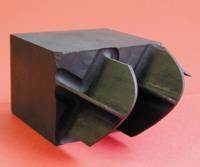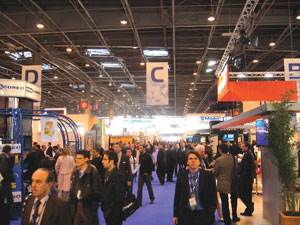The Myth of Cutting Tool Cost
Evaluating machining productivity by comparing tooling cost to tooling productivity.
Productivity in economics refers to a measure of output from production processes compared to a unit of input. In manufacturing, that unit of input refers to everything from toilet paper to your CEO’s company car. This cost/benefit ratio is determined by every shop differently and individually.
In cutting tools, this decision is often deterred by the idea of costs. However, the cost of cutting tools should only be a small portion of determining your shop’s machining productivity. Whether you are using very expensive cutting tools or lower-cost insert technology, it is the productivity of the tooling that should be considered when you are determining the actual cost of the tool. This article will evaluate machining productivity by comparing tooling cost to tooling productivity.
Tooling Cost Myth
Tool life in the past was determined by the amount of time a tool could be used before it needed to be replaced. Today tool life must be determined by the amount of work completed and the overall time it took to complete the work. If you determine tool life as a matter of physical time then you are potentially losing out on productivity and profitability.
Newer high-tech tooling is able to run at much higher speeds and feeds to get more machining done quicker; and, run a little slower but machine more surface area, allowing for more unattended machining. Either way the end result will be much better than if using standard, less advanced tooling.
Data Collection
With most of the advanced cutting tools, shops are able to make the choice between getting a job done quicker or saving tool life at the price of slower cycle time. The following application tests will show roughing and finishing of a mold core and the difference between high technology, higher cost tooling versus less expensive tools.
Roughing
Roughing Example 1
P20 Mold Core
Milling with a round insert button cutter
1 inch diameter, 2 flute
RPM 4500
Feed 120 IPM
Insert cost: $8.00 each
Insert able to complete one core, but must be rotated at two-hour intervals
Total insert cost: $16.00
Cycle time: 5 hours 30 minutes
Shop rate: $100.00 per hour
Total cost per core: $566.00
Roughing Example 2
P20 Mold Core
Solid carbide 4 flute high-feed tool
.500 inch diameter
RPM 5000
Feed 350 IPM
Tool cost: $100.00 each
Tool able to complete the part with no operator intervention
Cycle time: 2 hours 0 minutes
Shop rate: $100.00 per hour
Total cost per core: $300.00
Conclusion
It is very obvious that the cost of the cutting tool was much higher in Example 2, but there are three big differences in the examples.
1. The total cost to rough each identical core was much less in Example 2 even though the tooling cost was more than six times the price.
2. In Example 1 there was added time for operator intervention as the insert had to be rotated. This is a manual operation and the costs and time to rotate the insert was not included in the cycle time.
3. In Example 2 the core was machined with a smaller diameter tool, which eliminated some re-roughing routines because the part was machined closer to net shape.
Finishing
Finishing Example 1
Large P20 mold core
Milling Insert cost: $30.00
Tool diameter .750 inch
RPM 12000
Feed 240 IPM
Insert able to complete one core
Cycle time to finish machine one core: 6 hours
Shop rate: $100.00 per hour
Total cost per core: $630.00
Finish Example 2
Large P20 Mold Core
Milling Insert cost: $30.00
Tool diameter .750 inch
RPM 6000
Feed 120 IPM
Insert able to complete two cores
Cycle time to finish machine one core: 12 hours
Shop rate: $100.00 per hour
Total cost per core: $1215.00
Conclusion
It appears to be obvious that Example 1 is less expensive per core and many shops choose this method. The shorter cycle time in Example 1 also allows for more cavities or cores to be machined. If the cycle time is 6 hours and your shop runs 24 hours a day you should be able to complete three or four cores per day. In Example 2 the maximum cores that could be completed in a day would be two. For the shops with only one or two shifts, which like to run unattended or overnight, then Example 2 might be more cost-effective since the shop rate is basically free because the machine would have been turned off anyway. In Example 2 the insert is able to be used for another core, but the savings is only $15.00, which is not much considering the shop rate per hour.
It is possible to combine these examples where during the day when the machine is attended, the machining parameters are turned up. In the evening a new tool can be loaded and the cutting parameters lowered, so that the machine can run all night without operator intervention.
The Tooling
Typically a multiple insert or less advanced tooling does not have the accuracy required for finishing. If accuracy is important to the end product then surface finish off of the machine should also be important. Hand benching or polishing takes time and also reduces accuracy. More advanced cutting tools can create both the surface quality and accuracy to eliminate or at least vastly reduce the amount of benching required to obtain the finished results.
A typical example of finishing accuracy and surface finish is using a standard as pressed insert, which might be cheap, but the accuracy of the tool will be quite bad. The surface finish produced by such a tool will not be good either. The tool normally must run at a lower rpm and feed as well. The tool might be cheap, but the expense of the longer cycle time and additional benching will almost always end up costing much more.
The more advanced solid carbide tooling will have a thicker core, which makes them much stronger. The thicker core also will allow the heat generated in the cut to be displaced quicker—allowing for better tool life.
Applications Support
Keeping up to speed on the newest innovations in cutting tools and coatings should be of the utmost importance. Managers, as well as lead operators, should create and maintain a relationship with the applications staff of the cutting tool company to ensure you have the latest and greatest products and coatings.
It is difficult to just read an advertisement or article to obtain information that might be useful to your specific application. Most ads are general information ads and do not necessarily apply to your shop. If you see something interesting you need to make the call and research if it would be suitable to your application. If it seems to be something useful you really need to test the product. Testing takes away from machining time, but often the tests can save much more time and money in the end.
When contacting the cutting tool manufacturer you should ask for their applications staff, not the sales force. The salespeople will have basic knowledge of the tooling, but often they do not have the applications knowledge to discuss your particular situation. The first question you should ask the applications person is, “Are you skilled in high performance machining processes?” If they are not, ask for someone that is.
When contacting the applications staff you should have some basic information available to offer the applications engineer: the material being machined, the hardness of the material, the type of machine you have, the maximum rpm of the machine, the maximum feedrate available on the machine, the total depth you are required to machine, the spindle interface (HSK, CAT40) and the type of toolholder being used.
If you are trying to get specific information regarding a particular part you also should have available any details of the part, such as corner radii requirements. This should help to obtain quality information in the shortest amount of time.
Once you receive the information you should determine if the tooling is something you should test, find out the test policy of the cutting tool company and test the tooling.
Testing is the only way to know if the product will enhance your processes and bottom line.
The Process
The machining process for high-performance machining has been discussed for a long time now, but some shops still resist change. The process is actually fairly easy once you know the basic rules. At this point almost all of the programming software companies have the processes built into their software. Keeping up to date with software updates is important to make sure you can use the best processes available by the latest versions.
Productivity gains can be seen even in older machines with slower rpm spindles by using HPM processes.
Some of the newer designs of high-feed tooling end up working very well on slower, older machines. They are developed to run at lower cutting speeds, but higher feed-per-tooth. The process is still using the smaller depths-of-cut, but at much higher chip loads—up to .040 per tooth.
The high-performance machining process has always been one of taking smaller depths-of-cuts—normally 6 to 10 percent of the diameter of the cutter and a step over of between 10 and 40 percent of the diameter of the cutter.
This sounds as if it would be slower than taking a large depth-of-cut, but in actuality the part can be machined much faster, in most circumstances. By taking the shallow depth-of-cut, the part—after roughing—is much closer to net shape allowing the subsequent semi-finish and finish to be completed quicker. Depending on the part geometry, the semi-finish process can be eliminated completely. The HPM roughing process is often faster than the old conventional process.
Summary
After years of discussing cutting tool costs with customers, some companies insist on purchasing the lowest cost tools and others have found that they need to research all cutting tools, no matter the cost, to see which gives the best bang for their buck.
Often by testing the tooling from multiple manufacturers you can discover that the lowest price is not the best choice. If you purchase tooling by price only it is probably costing you money. You also are losing all of the benefits that can be seen by the more advanced products. Some of the tests that have been conducted between high performance, more expensive, tooling have revealed as much as 20 times the tool life and/or productivity.
Cutting tool choice—as well as the process used to machine—can greatly reduce cycle times, which allows for more capacity with the same amount of employees and machines.
Related Content
Revisiting Some Hot Runner Fundamentals
What exactly does a hot runner do? If you’ve been in the injection molding industry for any length of time, you might think the answer is obvious, but it is not.
Read More6 Ways to Optimize High-Feed Milling
High-feed milling can significantly outweigh potential reliability challenges. Consider these six strategies in order to make high-feed milling successful for your business.
Read MoreFundamentals of Designing the Optimal Cooling System
The right mold components can help improve mold cooling and thereby produce higher-quality parts.
Read MoreAdvantages and Disadvantages of Copper and Graphite Electrodes
Both copper and graphite provide approximately the same end result, so it is important for a shop to consider the advantages and disadvantages of each material in order to discover what would work best in their shop floor environment.
Read MoreRead Next
The Key to Controlling Your Machining Process
Controlling heat is the most important factor in high-speed and hard metal machining.
Read MoreUsing High-Feed Machining Strategies to Get to Net Shape
High-feed tooling and high-feed machining could be the key factor in maximizing your shop’s roughing efficiency.
Read MoreHow to Use Strategic Planning Tools, Data to Manage the Human Side of Business
Q&A with Marion Wells, MMT EAB member and founder of Human Asset Management.
Read More



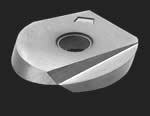

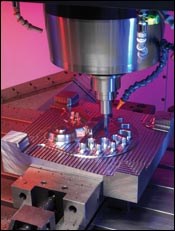
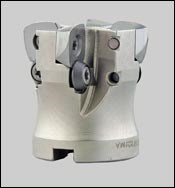





.png;maxWidth=300;quality=90)









